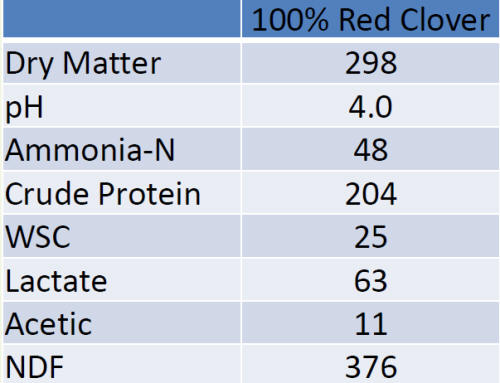



Consider Red Clover Silage
Speaking at the Dairy and Livestock Event 2010, Rhun Fychan from the University of Aberystwyth told attendees of a feed seminar why red clover silage could be beneficial for livestock and dairy farmers. Charlotte Johnston, TheCattleSite junior editor reports.Why red clover?
Red clover can contribute to the nitrogen economy of grassland, said Mr Fychan. With careful management it can produce high yielding and high quality silage.
It also has higher nutritional values and higher voluntary intake than traditional white clover.
Establishment
Establishment requires a pH value greater than 5.8. For the red clover to grow, no nitrogen should be applied, however moderate levels of potassium and high levels of potash are needed.
It should be sewn in early August, or if possible late July. It requires a fine, firm and level seedbed, and seeds must be broadcast no deeper than 1.5cm (11/2 ").
My Fychan suggested that red clover on its own should be sown at 12-15 kg/ha (5-6kg/ acre).
If sowing with hybrid or Italian ryegrass then seed rates are more likely to be 20kg/ ha (8kg/ acre) ryegrass and 10kg/ha (4kg/ acre) red clover.
Mr Fychan recommends considering a cover crop, such as whole crop barley when planting red clover.
Sward Management
Mr Fychan said that red clover is a very flexible crop, which can be grazed or cut.
"Growth rates are fastest in June/ July, hence this is the optimum time to ensile the crop, as cutting will ease management."
He warned producers that bloat is a known problem.
Red clover must remain well rested over winter. He said it is acceptable for sheep to graze the ground for short periods of time, but other graing will likely damage the crop.
For weed control, Mr Fychan advised using glyphosate pre-ploughing.
Dock control is necessary in established crops. If red clover is grown on its own then propyzamide should be used during the winter to control grass and perennial weeds.
When to cut?
The later red silage is cut, the higher the yield will be, Mr Fychan said.
If cut in early May, at its vegetative state, he said that expected first cut yields could be about 3000 kg/ dry matter (DM)/ ha.
Mr Fychan said that by waiting until the crop has flowered, around the beginning of June, will mean higher yields - however there is a risk of lodging.
"When cutting it is important to ensure that enough root is left for crop regrowth," he said.
In future years, Mr Fychan said that cutting the late bud stage will produce higher yields.
Ensiling
To avoid lead shatter when ensiling, Mr Fychan recommends not using conditioners, not tedding and raking before dew rises from the crop.
The low sugar content of red clover could be an issue, which is why Mr Fychan said either ensile in bales, using 6 layers of wrap on bales or an added inoculant in clamps.
In hybrid grass, sugar content is around 25 per cent of DM, but in red clover it is only 10 per cent. For best results, red clover should be ensiled when a DM of 30-35 per cent has been reached.
When deciding whether to clamp or bale, Mr Fychan said that there is a higher sugar content achieved when baling red clover as fermentation is more efficient.
Quality of silage

Table 1 shows the quality of the red clover silage as a mean of three cuts over two years.
"Inoculation of red clover in silage will increase average crude protein content levels by three to four per cent," he said.
Table 2 shows the comparison of a ryegrass only silage and a mixture of ryegrass and red clover silage.

"Replacing ryegrass silage with red clover silage will typically increase milk production by three to four per cent."
Research from the silage advisory centre shows that dry matter intake increases when red clover is fed, by 2.4 kg/ day. This in turn increases milk yield by 4kg/ day.
At the IBERS Trawsloed Dairy Farm, 25 ha of 100 per cent red clover is planted in an arable rotation, with three cuts taken per annum.
Red clover then contributes to 10 per cent of total mixed ration, and is fed to 250 Autumn calves.
Yields
According to Mr Fychan, the highest yielding cut will always be the second.
He said that red clover will compete well with weeds until the third harvest.
A crop on its own can expect yields of 13 tonnes/ DM/ ha/
However if planted with ryegrass then yields can be between 15-16 tonnes/ DM/ ha.
The above yields can only be expected if no nitrogen is applied, he said.
Although yields from red silage may be slightly lower than perennial ryegrass and hybrid ryegrass, Mr Fychan said that it is important to remember that no nitrogen is required.
Conclusion
Concluding, My Fychan said that red clover can fix 250kg of nitrogen per hectare per annum so reducing reliance on inorganic nitrogen fertiliser.
Red clover can be ensiled successfully, with wilting and the use of additives being beneficial.
Using red clover will improve animal production due to its higher nutritional value and increased intake per animal.


